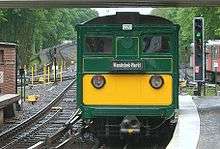Hamburg U-Bahn Type A
| HHA-Baureihe A/B/T/TU1/TU2 | |
|---|---|
 HHA Type A built in 1920 | |
| In service | 1912–1970 |
| Manufacturer | AEG, Busch, Credé, Falkenried, Siemens, Waggonbau Görlitz |
| Constructed | 1911-1929, 1940, 1943 |
| Entered service | 1912 |
| Refurbishment | 1947-49 + 1959-61 |
| Scrapped | 1970 |
| Number built | 377 cars |
| Number preserved | 6 cars (1 converted to work service)[1] |
| Number scrapped | 371 cars |
| Fleet numbers | 11-417 |
| Capacity | 34 seats [2] |
| Operator(s) | Hamburger Hochbahn AG |
| Depot(s) | Barmbek |
| Specifications | |
| Train length | 12.80 m (42 ft 0 in) |
| Width | 2.56 m (8 ft 5 in) |
| Height | 3.14 m (10 ft 4 in) [2] |
| Doors | 4 per car |
| Maximum speed | 60 km/h (37 mph) [2] |
| Weight | 24.6 t (24.2 long tons; 27.1 short tons) [2] |
| Prime mover(s) | 2x AEG U109 with 81 kW |
| Power output | 162 kW (220 hp) |
| Acceleration | 0.6m/s² |
| Electric system(s) | 750 V DC |
| UIC classification | Bo'Bo' |
| Braking system(s) | Knorr air main brakes |
| Safety system(s) | Sifa |
| Track gauge | 1,435 mm (4 ft 8 1⁄2 in) |
The Type A (since late 1950s Type T) is a subway car type built for Hamburg Hochbahn. It was first constructed in 1911 and it was the first type of subway cars in Hamburg. Their passenger service began on the Rathausmarkt - Barmbeck line on 15 February 1912.
History
The first discussions about developing a new subway system in Hamburg began in the 1890s, in 1906, the first short stretch of the Ringbahn (Circle line, now U3 line) near Uhlandstraße was built. In October 1911, the first cars arrived.
Construction
The body of the cars rested on a steel substructure, while the body consisted of a wooden frame which was clad with metal panels. Most of the cars had a driver's cab at one end of the car, some cars were delivered with a second driver's cab to use a single car for branches with low traffic volume. In 1929 the delivery of the last cars was completed for the moment but in 1940 and 1943, some new cars for testing purposes for new electrical components were constructed but because of the Second World War they have been delivered without their electrical components. In 1946, they received conventional components to stay compatible to the older cars.
Rebuilding
In the Second World War, some cars had been destroyed in the Bombings of Hamburg. After the war, beginning in 1947, the destroyed cars had been lengthened and rebuilt. To differ the undamaged cars from the rebuilt cars, the undamaged cars were designated as A cars, the rebuilt cars as B cars. In 1955, every single car has been equipped with a speedometer and an odometer. In the late 1950s, the A cars were renamed in T cars, the rebuilt B cars were renamed in TU1 cars. Beginning in 1959, 100 T cars were refurbished to lower the maintenance costs. These cars were called TU2 and were rebuilt and clad with stainless steel instead of metal panels. This procedure was completed in 1961.
Withdrawal
The first cars were retired in October 1965, the last cars which were TU2 in December 1970. They had been replaced by DT2 and DT3 trains. Some cars had been converted to maintenance service cars. In 2012 only six cars are left, four of them are still operational as heritage train.[3]
Gallery
-

B car or TU1 car
-

TU2 car
-
Driver's cabin of a T car from 1920
References
- ↑ hochbahnbuch.de - German - restored trains
- 1 2 3 4 hamburger-untergrundbahn.de - German - Section "Die ersten Hochbahnwagen"
- ↑ Heritage trains. - German
External links
- http://www.hamburger-untergrundbahn.de/ - German - History about the Hamburg U-Bahn
- http://www.hochbahnbuch.de/ - German - Detailed informations about subway cars of the Hamburg U-Bahn